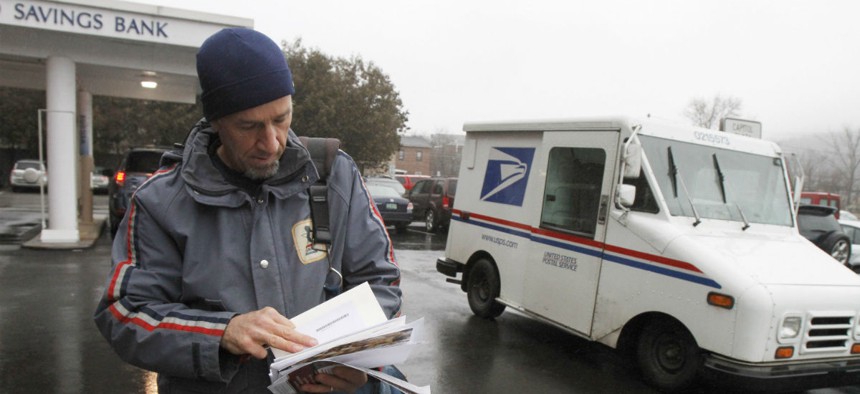
Toby Talbot/AP file photo
Amid USPS' Calls for Pay Cuts, Unions Let Deadline Pass for New Labor Contract
Postal Service's negotiations stall with two unions representing 300,000 employees.
Two postal unions representing more than 300,000 employees are struggling to reach new collective bargaining agreements with postal management, with one already abandoning negotiations in favor of mediation.
USPS’ contracts with both the American Postal Workers Union, which represents nearly 200,000 employees, and the National Rural Letter Carriers Association, which represents about 116,000 workers, were set to expire Thursday. Both unions agreed to extend the existing, 2010-2015 agreements until a settlement is reached.
APWU and postal management decided to extend negotiations for one more week in hopes of reaching a deal. The NRLCA, however, reached an impasse with the Postal Service, and a mediator will now step in.
APWU President Mark Dimondstein said his union has made some progress with USPS on work-floor issues, but too many disagreements persisted to strike a deal in the initial timeframe. The Postal Service has “insisted” on creating a new, permanently lower pay scale and reduced benefits for future career employees. It also asked for “givebacks” in pay and benefits from current workers.
“The union’s job is to fight for those who are part of the workforce today -- both career and non-career -- and for those who will be part of the workforce in the months and years ahead,” Dimondstein said. “If we fail to do that, over time we will undermine the wages and benefits of all our members.”
If the two sides are not able to reach an agreement, APWU too will go to mediation. If a deal still cannot be struck, the CBA will be determined in a binding arbitration process. After multiple extensions in 2010, APWU was able to reach a deal with USPS without going to arbitration. The union represents clerks, mechanics, vehicle drivers, custodians and some administrative positions.
Like it did on Thursday, NRLCA also reached an impasse with USPS in 2010 and a third party was called in. Concurrent to the negotiations, NRLCA is litigating a lawsuit it brought against the Postal Service for the agency’s failure to negotiate over the response to a breach that compromised postal employees’ personal information.
Dimondstein encouraged his members to continue to make their voices heard, saying their rallies are already having an impact at the negotiating table. Last week, APWU held a “national day of action,” which included protests against cuts at the Postal Service in 85 cities across the country.
“The Postal Service respects the bargaining process, and we prefer to keep the negotiations at the bargaining table,” said Darlene Casey, a USPS spokeswoman.
Postal unions have consistently called for investments in new areas for revenue growth rather than cuts to services, staffing levels and employee compensation. One much discussed, but controversial, proposal is postal banking, which the USPS inspector general’s office first floated last year. Critics of the plan, such as former Postmaster General Patrick Donahoe, have said the IG’s white paper was light on details and that the Postal Service should stick to what it knows.
The IG attempted to address both of those claims on Thursday, releasing an updated report on the practical ways USPS could institute financial services. Without requiring any additional authority, the Postal Service could allow customers to send electronic money transfers between post offices, expand check cashing and provide bill paying services to increase annual revenue by $1.1 billion within five years.
Other approaches spelled out by the IG would require new legal authority. By partnering with one or more banks, credit unions or other organizations, USPS could offer reloadable prepaid cards and small loans, the IG said. The Postal Service could also create its own full-fledged bank, which the IG admitted would be “lengthy and difficult” but would offer the most benefits in areas currently underserved by financial institutions.
Dimondstein quickly jumped on the proposal as exactly the kind of thing in which USPS should invest to grow business.
“It’s a no-brainer,” he said. “The inspector general report confirms that the Postal Service can act now to provide consumers with affordable financial services while strengthening our trusted national treasure, the public Postal Service.”
NEXT STORY: How to Know When It’s Time to Go







